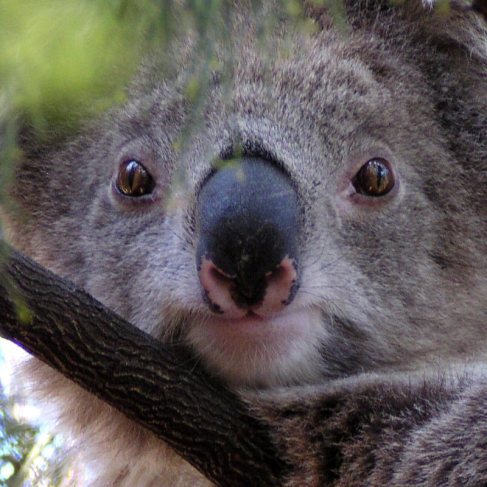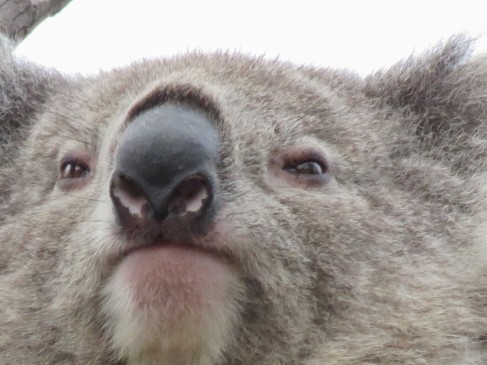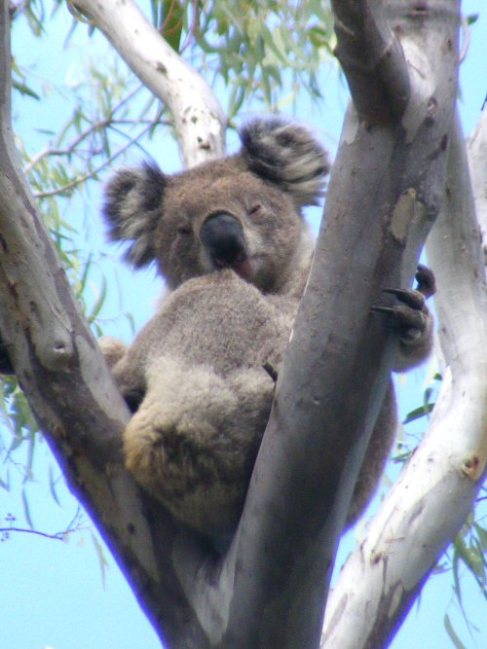Like whales, cheetahs, tigers and gorillas, koalas have individual distinguishing markings. Grab any postcard or Steve Parish wildlife calendar and have a good look at the koalas. They all have black noses. They all have some white/pink inside their nostrils – but hang on, that one looks different! You’ve got it. You’ve just seen your first koala nose pattern.
Don’t be surprised if you haven’t noticed it before. It took us a year of watching koalas to find it. Then it took about 8 years to be confident it didn’t change over a koala’s life.
 < Raini, her nose pattern is quite different to Pat’s – white goes all the way to her lips
< Raini, her nose pattern is quite different to Pat’s – white goes all the way to her lips
We first met Pat as a tiny joey clinging to her mother’s back. Frantically, we sketched her nose pattern and her mother’s before they looked away. Little did we know then that this mother-daughter pair were to become the most important koalas in our lives.
< Pat’s mother Smoky
Pat is now 8 years old, a mother of 3 sons, and possibly a grandmother. All her sons have their nose patterns recorded, but in the way of male koalas, they have all left her and gone to live elsewhere. We keep their nose patterns on file, but with 1500 hectares of You Yangs Park to explore, there is little chance we will be lucky enough to find them again. We don’t tag or radio-collar the koalas, so we rely on finding and observing them to gain our information.
In the You Yangs we search two areas of roughly 1.5km x 1.5km each (about 200 hectares). In each area we have around +/-20 individuals we see regularly – some only twice a year, some up to 120 times a year. We estimate these two areas of the You Yangs currently have a density of 1 koala every 10 hectares.
Of Pat’s three sons, her first and third left her at around 12-13 months of age and have never been seen again. Her second son, Clancy, was different though – he stayed around Pat until he was 20 months old, and then a miracle happened! He moved into our second research area and set up home.
<Pat with second son Clancy
Imagine our surprise as we stood looking at a ‘new’ small male koala, 2km from Clancy’s last known position, that seemed totally unconcerned by our presence. His nose pattern seemed familiar. It couldn’t be Clancy, could it? Cameras clicking madly, we checked and double-checked. He was the same size as Clancy. He had the same distinctive white spots on his back: 2 splashes on the right hip, one big one, one little one on the left. He ticked all the boxes. He was Clancy.
Clancy liked the new area, and set up home. He has grown, but his nose pattern hasn’t changed. He is now nearly 4 years old.
Back in Pat’s home, a dramatic event occurred at Christmas 2012. Pat’s mother, Smoky, died. The two females had shared a home range all their lives together, and had occasionally shared trees. On the day Smoky was found dead, Pat was only 20 metres away. Analysis of Smoky’s skull later found that she was over 15 years old.
Now 10 months after Smoky’s death, Pat is being seen less and less in her traditional home range. We don’t know why. Was proximity to her mother an important factor in Pat’s choice of home range? To complicate things further, Pat was recently seen in Clancy’s home range. What on earth would she need from him? And why, of all the 1500 hectares of You Yangs forest, would she show up 100metres from the baby who stayed with her nearly twice as long as her others?
These are just some of the fascinating outcomes we have had from an observational citizen-science research project. All because we looked up a koala’s nose and saw something exciting.
It remains to be seen whether Pat will visit Clancy again. We’ll keep you posted.
If you would like more information about koala nose pattern identification, please contact us at: janine@echidnawalkabout.com.au




I loved it keep up the good work! 🙂
Thanks Ava!